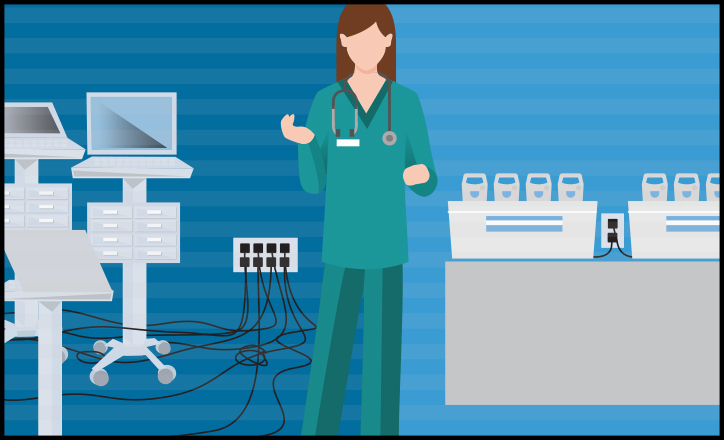
Corded vs Cordless EHR Workstations (pt 2): Factors to Consider
We are releasing a five-part blog series discussing the reasons why we recommend that hospitals choose cordless mobile EHR workstations for nurses to chart patient information. Mobile EHR workstations are either corded or cordless. When corded, they must be plugged in to charge. Cordless stations, however, use swappable battery technology. Cordless EHR workstations enhance workflow for nurses and increase real-time charting in the presence of the patient because they lessen the battery anxiety and the interruptions nurses may experience with corded options. Read our overview of all factors to consider in part one. For part two, we’ll delve into how cordless stations that use swappable battery technology enhance flexibility and efficiency and offer more convenience.
Flexibility
Mobile EHR workstations that use swappable battery technology, like Enovate’s MobiusPower®, don’t require plugging a cord into an electrical outlet for recharging. Instead, the batteries charge in a wall-mounted station and can be swapped quickly. Corded workstations, have an internal battery and must be plugged in to charge. If the internal battery runs low, a nurse must search for an available outlet and either do something else while the workstation is charging, continue to find outlets while going about a shift, or even swap workstations altogether. Corded solutions create battery anxiety about losing patient data. (We’ll talk more about this in our next blog post.) Instead of worrying, a nurse might opt to chart when back at the nurses’ station, rather than doing so face to face with the patient. With cordless solutions, nurses can chart in a room or in the hall without the hassle of finding a spot to plug in. They are never tethered to an outlet, waiting for a battery to charge.
Efficiency
Searching for an outlet and doing all that plugging and unplugging takes up valuable time. A hospital has many outlets, but those outlets may be occupied or inconveniently located. Cordless workstations, running on MobiusPower, don’t require down time to charge. They can operate continuously in the busy 24/7 hospital.
If a nurse swaps in a fully charged battery at the beginning of a shift, he or she will only need to swap again one more time during that shift. A nurse simply heads to the charging station within his or her nursing unit after hearing a warning beep indicating a battery is low. This beep won’t catch the nurse off guard, either. Enovate workstations running on MobiusPower display the battery time in hours and minutes. (We’ll talk more about how important a true time display is in our next blog post.) Nurses can plan ahead as to when during a shift to make the swap. After the warning beep, they still have 25 minutes of power remaining so they can continue to work with their current patient and then change batteries before visiting the next one.
Nurses swap batteries from an ergonomic holster to a conveniently located charging station and vice versa in a matter of six seconds. With cordless workstations, nurses have only one disruption per shift in which they’ll need to swap a battery instead of several disruptions to search for an outlet. The location of the wall-mounted charging station doesn’t change, eliminating the need for searching. The battery charging station has dedicated outlets to charge the batteries used to power the cordless mobile EHR workstations.
Convenience
A real-time monitoring solution, like RHYTHM (watch our video), integrates into a hospital’s native ticketing system, giving IT professionals real-time visibility on batteries and cordless EHR workstations. RHYTHM acts like a virtual technician and notifies the IT team if there is a problem. The system even provides a diagnosis so that an IT professional can act.
The Enovate technical support team has the same visibility on your fleet through RHYTHM, allowing collaboration between the two teams. Knowledgeable factory-trained technicians become an extension of the hospital technical team, reducing down time and increasing the availability of the workstations for nurses who are dependent on them to chart in real-time at the bedside.
Without RHYTHM, IT professionals must rely on nurses to write a work order. Nurses are trained in caring for people, not devices, and they shouldn’t have to halt their work with patients to write work orders and diagnose equipment during their already busy schedules. RHYTHM supports IT professionals so that they can support nurses. The system ensures that workstations are always available so nurses can spend more face-to-face time with patients.
At Enovate Medical, we take time with our clients, working directly with nurses and IT professionals, to conduct a thorough clinical device assessment (CDA). In doing so, our clients have lowered their overall capital outlay and reduced their operational expenses. Most importantly, they’ve achieved enhanced nursing workflow and therefore an improved patient experience.
Call today for a comprehensive clinical device assessment.

